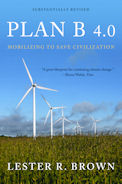Using Existing Technology to Secure Food Supplies
We face an extraordinary challenge, but there is much to be upbeat about. All the problems we face can be dealt with using existing technologies. And almost everything we need to do to move the world economy off the collapse path and back onto an environmentally sustainable path has already been done in one or more countries. For example, more than 30 countries have essentially stabilized their population size.
We see the components of Plan B in technologies already on the market. On the energy front, for example, we can get more energy from an advanced-design wind turbine than from an aging oil well. The new plug-in gas-electric hybrids coming to market, like the Chevrolet Volt, can get up to triple-digit miles per gallon. In the Plan B energy economy of 2020, most of the U.S. fleet will be plug-in hybrids and all-electric cars, and they will be running largely on wind-generated electricity for the equivalent of less than $1 a gallon of gasoline.
The world is in the early stages of a revolution in lighting technology. We know that compact fluorescent lamps (CFLs) can provide the same lighting as century-old incandescent bulbs but use only one fourth as much electricity. Even more exciting, we are now looking at a still more-advanced lighting technology—the light-emitting diode (LED)—which uses 15 percent of the electricity used by an incandescent bulb. Shifting from incandescents to LEDs and installing motion sensors and dimmers can reduce electricity used for lighting by more than 90 percent.

As for Plan B models at the national level, Denmark today gets more than 20 percent of its electricity from wind and has plans to push this to 50 percent. Some 27 million Chinese homes get their hot water from rooftop solar water heaters. Iceland, which heats 90 percent of its homes with geothermal energy, has virtually eliminated the use of coal for home heating.
We see what a Plan B world could look like in the reforested mountains of South Korea. Once a barren, almost treeless country, the 65 percent of South Korea now covered by forests has checked flooding and soil erosion, returning environmental health and stability to the Korean countryside. The United States—which over the last quarter-century retired one tenth of its cropland, most of it highly erodible, and shifted to conservation tillage practices on part of the remainder—has reduced soil erosion by 40 percent. Meanwhile, the grain harvest expanded by one fifth.
Some of the most innovative leadership has come from cities. Curitiba, Brazil, began restructuring its transport system in 1974, and in the two decades that followed the city cut car traffic by 30 percent while its population doubled. Amsterdam has a diverse urban transport system where some 40 percent of all trips within the city are taken by bicycle. London is taxing cars entering the city center and investing the revenue in upgrading public transit.
The challenge is to build a new economy at wartime speed before we miss so many of nature’s deadlines that the economic system begins to unravel. Participating in the construction of this enduring new economy is exhilarating. So is the quality of life it will bring. A world where population has stabilized, forests are expanding, and carbon emissions are falling is within our grasp.
Adapted from Chapter 1, “Selling Our Future” in Lester R. Brown, Plan B 4.0: Mobilizing to Save Civilization (New York: W.W. Norton & Company, 2009), available on-line at www.earthpolicy.org/index.php?/books/pb4
Additional data and information sources at www.earthpolicy.org
Support artisans in impoverished countries: browse our selection of fair trade jewelry
Image credits:
http://www.flickr.com/photos/24975813@N00/ / CC BY 2.0

